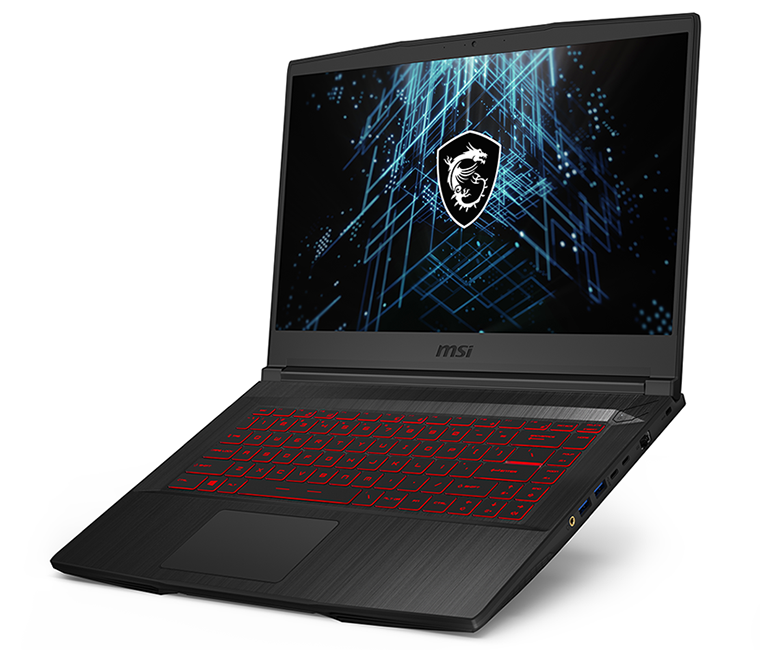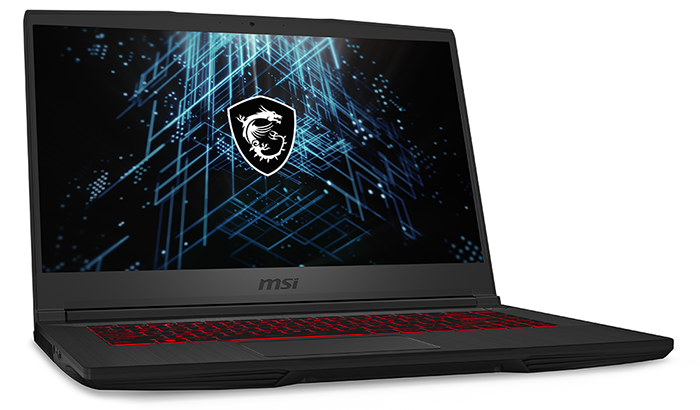Introduction
When you consider that we recently tested a gaming laptop costing over £4,000, the MSI GF65 Thin can be deemed a relative bargain. For the small sum of £1,100, this 15.6in system touts a 1080p 144Hz display that bodes well for super-smooth gaming, and there ought to be plenty of oomph under the hood to drive high refresh rates at the native resolution.
A good deal in these otherwise crazy market conditions? Perhaps, though at this end of MSI's portfolio there are some concessions to be made. The GF Series can be deemed an entry-level solution, and as such the chassis is noticeably simpler than premium competitors. That means thin plasticky outer materials, some flex in the lid and palm rest, and a shiny black finish that has a nasty habit of attracting fingerprints and grime.
Still, you wouldn't expect a £1.1k gaming laptop to be built of vibranium, would you? Conversely, if your expectations are modest, you might appreciate the fact that the 359mm x 254mm x 21.7mm chassis is reasonably easy to slip into a rucksack, and at 1.9kg, it isn't a chore to carry around.
A more pressing concern for the target audience is the firepower residing within, and given the fee, there's a decent amount of weaponry to play with. MSI uses a six-core Core i7-10750H processor from Intel's 10th Gen stable, and the 45W chip is paired with 16GB of dual-channel DDR4-3200 memory, a spacious 1TB Samsung PM991 M.2 SSD and latest-gen Nvidia GeForce RTX 3060 Laptop graphics.
Useful on-paper specs, yet Nvidia's RTX 3000 Series has caused confusion by allowing each grade of GPU to be made available in a broad array of power envelopes. The 6GB RTX 3060 Laptop part can be configured by OEMs to a TDP of between 60 and 115W, resulting in a large gulf in performance depending on implementation. In this instance, MSI takes a reserved approach by adopting a 75W setup that allows for boost speeds of up to 1,402MHz. Point is, this is a mid-range GPU operating at the lower-end of the spectrum, though we don't imagine that to be much of an issue at 1080p.
A full-HD 1,920x1,080 resolution is a sensible choice and a native 144Hz refresh rate makes good sense for a system whose primary purpose is gaming. Don't, however, expect the IPS panel to excel in all other areas. Colour coverage is well below average, peak brightness of 260 nits leaves something to be desired, and on-screen visuals just don't carry the wow factor of today's brightest panels.
That feeling of decent-enough is applicable throughout the laptop. MSI's keyboard - backlit only in red and absent RGB effects - doesn't offer a great deal of travel but is quiet during use and has the added benefit of full-size arrow keys. The accompanying trackpad, though precise and well-sized, exhibits some wobble and the 720p webcam doesn't provide much to write home about, either; image quality is basic, but at least the webcam is above the display, where it ought to be.
Stereo speakers provide plenty of volume but little in the way of bass, and connectivity is, again, decent with Wi-Fi 6, Gigabit Ethernet, a combination audio jack, HDMI output and four USB 3.2 Gen 1 ports (two Type-C and two Type-A). Nothing fancy - you don't get Thunderbolt nor DisplayPort over Type-C - and if we're being ultra-critical it's a shame all four USB ports are located on the laptop's right side; we'd prefer at least one on the left.
Those who see the GF65 Thin as a gaming platform to use in multiple locations will appreciate the slim 180W power supply, however there is a caveat in that the internal 51Wh battery provides limited longevity away from the mains. Battery life isn't a strong suit, fan noise is bothersome (more on that later) and there is some bloatware to contend with atop the 64-bit install of Windows 10 Home.
We seem to have identified a few niggles, yet none should come as a surprise on a budget gaming laptop. MSI's GF65 Thin will live or die on its ability to punch higher than the price tag suggests, so let's see run the numbers, shall we?





